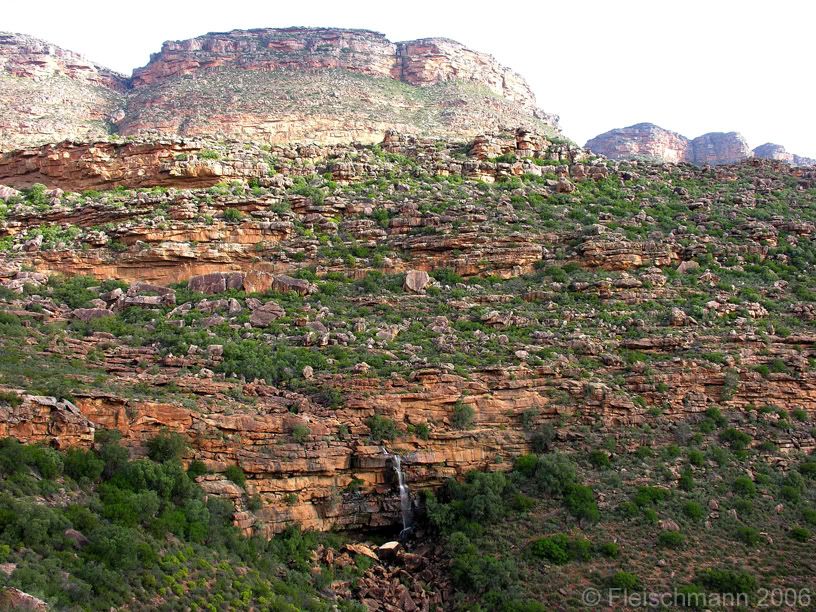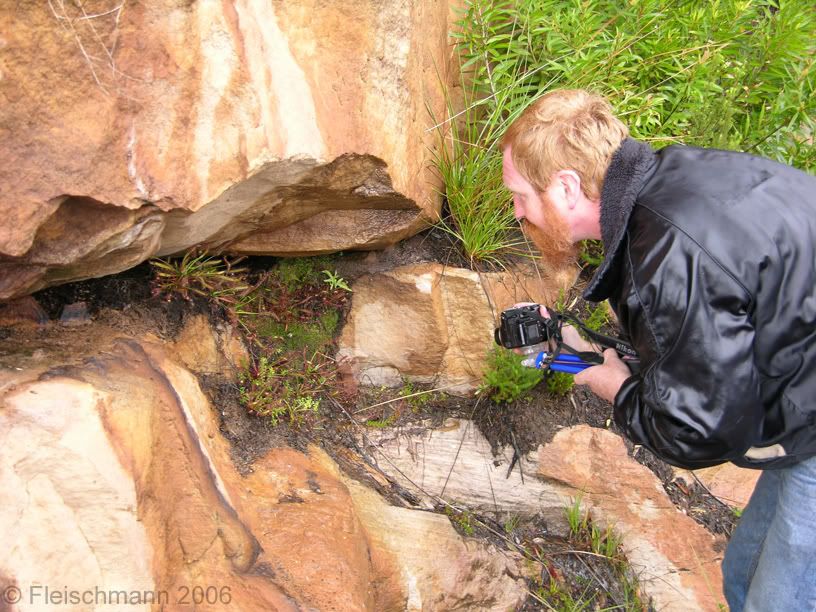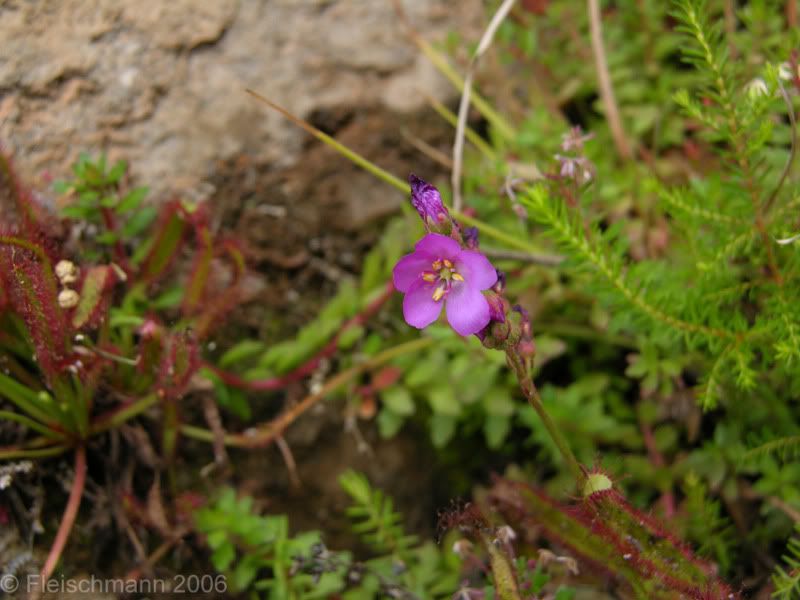Post by andreasfleischmann on Aug 24, 2009 23:56:16 GMT
Drosera capensis is probably the most commonly cultivated sundew, and may become a serious noxious weedy where it got naturalized in suitable habitats. Surprisingly, this easy grower is not the most common Drosera species of the Cape area (this is without doubt the summer dormant geophyte D. trinvervia, which grows in every spot that supports CP growth, comparable to the annual D. glanduligera in Western Australia).
D. capensis is widespread in Southern Africa, however not a common plant! It grows very localized, and usually in rather small populations.
It is a plant of very wet spots, which are at moist even at the top of the dry season (those are usually rare in the seasonally fynbos vegetation of the Cape), like seepage areas, shores of lakes and rivers, wet water-filled depressions, roadside ditches, sphagnum bogs or dripping walls over rocks.

The darker part in the middle is a wet depression with seeping cool water, where the “narrow leaf”-type of D. capensis was found.

Here, D. capensis „narrow leaf“ grew in patches of poor soil between white quartz gravel. Accompanying CPs were Utricularia bisquamata ‘small flower’ (the weedy one!). Maybe you can even spot some developing scapes of the Utricularia in the left corner of the photograph. In drier, higher elevated spots (which become dry in summer), Drosera trinervia and D. zeyheri could be found.

Trio of D. capensis .
.

At a different location far more to the North of the Western Cape, at Giftberg (Afrikaans for “toxic mountain”), tepui-like mountain plateau of red sandstone, another form of D. capensis grows in a totally different habitat:

This is where all D. capensis ‘red’ in cultivation originate from! The plants of D. capensis which grow at Giftberg are getting an all red colour when grown in full sun.
However, in the wild, D. capensis usually prefers slightly shaded conditions, and is often growing on dark S- or SE-facing walls (like European Pinguicula, which prefer NW- or NE-facing walls).


The wet dripping wall habitat of D. capensis at Giftberg did remind me much of Pinguicula sites in Europe. However this is sandstone, not limestone, thus acidic conditions of course!

D. capensis grows in a thin waterlogged carpet of mud and algae over the rock surface. Interestingly, a pink-flowered form of D. trinervia with quite long scapes grows sympatrically with D. capensis ‘red’ on these dripping walls. This is remarkable, because all other locations, where D. trinervia profoundly grows seem to dry out during the hot African summer. Maybe this is an “evergrowing” D. trinvervia? However, as all plants of those D. trinervia just had a few rosette leaves (like their white flowered sisters of seasonally wet habitats), I assume that they are dying back to dormant roots even if conditions are wet year-round. Just like the tuberous D. auriculata, which can well stand permanently wet soils, too, and which goes dormant nevertheless.

At every suitable spot where at least some water is permanently seeping through fine cracks of the red sandstone, D. capensis was able to settle directly in the rock cavities.
In more shaded conditions (like underneath overhanging rocks), the plants grew bigger (up to 30 cm in diameter!), but did not get as colourful as plants growing in brighter spots receiving more sun at least for some part of the day.

Famous sundew expert Dr. Robert Gibson carefully observing D. capensis growing in the shelter of a ledge.

The only flower of D. capensis we found in September (out of season).
All the best,
Andreas
D. capensis is widespread in Southern Africa, however not a common plant! It grows very localized, and usually in rather small populations.
It is a plant of very wet spots, which are at moist even at the top of the dry season (those are usually rare in the seasonally fynbos vegetation of the Cape), like seepage areas, shores of lakes and rivers, wet water-filled depressions, roadside ditches, sphagnum bogs or dripping walls over rocks.

The darker part in the middle is a wet depression with seeping cool water, where the “narrow leaf”-type of D. capensis was found.

Here, D. capensis „narrow leaf“ grew in patches of poor soil between white quartz gravel. Accompanying CPs were Utricularia bisquamata ‘small flower’ (the weedy one!). Maybe you can even spot some developing scapes of the Utricularia in the left corner of the photograph. In drier, higher elevated spots (which become dry in summer), Drosera trinervia and D. zeyheri could be found.

Trio of D. capensis
 .
.
At a different location far more to the North of the Western Cape, at Giftberg (Afrikaans for “toxic mountain”), tepui-like mountain plateau of red sandstone, another form of D. capensis grows in a totally different habitat:

This is where all D. capensis ‘red’ in cultivation originate from! The plants of D. capensis which grow at Giftberg are getting an all red colour when grown in full sun.
However, in the wild, D. capensis usually prefers slightly shaded conditions, and is often growing on dark S- or SE-facing walls (like European Pinguicula, which prefer NW- or NE-facing walls).


The wet dripping wall habitat of D. capensis at Giftberg did remind me much of Pinguicula sites in Europe. However this is sandstone, not limestone, thus acidic conditions of course!

D. capensis grows in a thin waterlogged carpet of mud and algae over the rock surface. Interestingly, a pink-flowered form of D. trinervia with quite long scapes grows sympatrically with D. capensis ‘red’ on these dripping walls. This is remarkable, because all other locations, where D. trinervia profoundly grows seem to dry out during the hot African summer. Maybe this is an “evergrowing” D. trinvervia? However, as all plants of those D. trinervia just had a few rosette leaves (like their white flowered sisters of seasonally wet habitats), I assume that they are dying back to dormant roots even if conditions are wet year-round. Just like the tuberous D. auriculata, which can well stand permanently wet soils, too, and which goes dormant nevertheless.

At every suitable spot where at least some water is permanently seeping through fine cracks of the red sandstone, D. capensis was able to settle directly in the rock cavities.
In more shaded conditions (like underneath overhanging rocks), the plants grew bigger (up to 30 cm in diameter!), but did not get as colourful as plants growing in brighter spots receiving more sun at least for some part of the day.

Famous sundew expert Dr. Robert Gibson carefully observing D. capensis growing in the shelter of a ledge.

The only flower of D. capensis we found in September (out of season).
All the best,
Andreas






